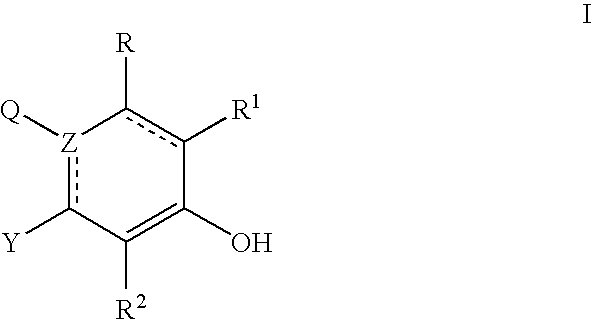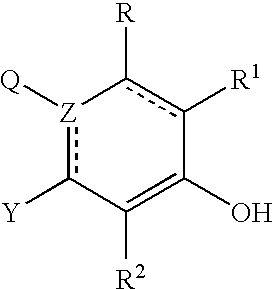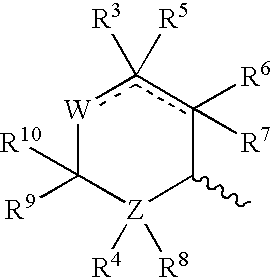Abnormal cannabidiols as agents for lowering intraocular pressure
a cannabinoid and cannabinoid technology, applied in the field of abnormal cannabinoid to lower intraocular pressure, can solve the problems of pupilar blockage, acute attack, impeded aqueous humor drainage, etc., and achieve the effect of lowering intraocular pressure, potent ocular hypotensive agents, and reducing ocular surface hyperemia
- Summary
- Abstract
- Description
- Claims
- Application Information
AI Technical Summary
Benefits of technology
Problems solved by technology
Method used
Image
Examples
example 1
[0075]Intraocular pressure was measured by applanation pneumatonometry in conscious animals. The test compound was administered topically to one eye while vehicle was given to the fellow eye in a masked fashion. Laser-induced unilaterally ocular hypertensive Cynomolgus monkeys (females) were dosed once and the IOP was measured over the course of 24 hours.
[0076]The results are shown in the Table, below wherein the stars indicating the potency of the compound. That is, one star indicates no potency, three stars indicates a very potent compound.
[0077]
Example No.EfficacyVehicle*5***16 (c) Tetrahydropyridine derivative**20 Piperidinedione derivative***9 (b) Cyclohexane derivative***
example 2
Determination of Abnormal Cannabidiol Activity
[0078]Abnormal Cannabidiol receptor activity may be measured in accordance with the procedure disclosed in (Wagner J A et al., Hypertension 33 [part II], 429 (1999); Járai Z et al., PNAS 96, 14136 (1999), which is hereby incorporated by reference in its entirety.
[0079]When measured according to this assay all of the compounds of the Examples, below, are found to be active.
Experimental Details for Synthesis of Abnormal Cannabidiols
General Route
[0080]
example 3
Synthesis of 4-(6-Isopropenyl-3-methylcyclohex-2-enyl)-5-methylbenzene-1,3-diol
[0081](4R)-1-Methyl-4-isopropenylcyclohex-2-ene-1-ol (300 mg, 2 mmoles) was dissolved in toluene (20 ml) and 5-methylresorcinol (248 mg, 2 mmoles) was added in diethyl ether (5 ml). Oxalic acid dihydrate (252 mg, 2 mmoles) was added and the reaction mixture heated with stirring at 80° for 5 hours. The reaction mixture was allowed to cool and diluted with diethyl ether (30 ml). The ether solution washed twice with aqueous sodium bicarbonate and dried over anhydrous magnesium sulphate. The solvents were evaporated under reduced pressure to give the crude product as a brown oil (800 mg). The product was purified using a silica column eluted with ethyl acetate:isohexane 1:9 going to ethyl acetate:isohexane 2:8.
[0082]The product was isolated as a yellow gum (106 mg)
[0083]1H NMR (300 MHz, CDCl3) 6.2 (M, 2H), 6.1 (S, 1H), 5.55 (M, 1H), 4.7 (M, 1H), 4.55 (S, 1H), 4.5 (M, 1H), 3.55 (M, 1H), 2.5 (M, 1H), 2.2 (M, 2H...
PUM
| Property | Measurement | Unit |
|---|---|---|
| volume | aaaaa | aaaaa |
| pressure | aaaaa | aaaaa |
| pH | aaaaa | aaaaa |
Abstract
Description
Claims
Application Information
 Login to View More
Login to View More - R&D
- Intellectual Property
- Life Sciences
- Materials
- Tech Scout
- Unparalleled Data Quality
- Higher Quality Content
- 60% Fewer Hallucinations
Browse by: Latest US Patents, China's latest patents, Technical Efficacy Thesaurus, Application Domain, Technology Topic, Popular Technical Reports.
© 2025 PatSnap. All rights reserved.Legal|Privacy policy|Modern Slavery Act Transparency Statement|Sitemap|About US| Contact US: help@patsnap.com



